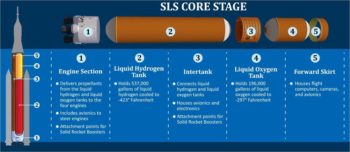Originally, the first uncrewed mission of the combined Space Launch System (SLS)/Orion system known as Exploration Mission-1 (EM-1) had a launch readiness date of December 2017,
The first crewed mission of the system known as Exploration Mission-2 (EM-2) was projected to launch in mid-2021.
Launch slips
However, a new NASA Office of Inspector General (OIG) report has found, due to continued production delays with the SLS Core Stage and upcoming critical testing and integration activities, current NASA schedules indicate launch dates of mid-2020 and mid-2022, respectively.
With $5.3 billion expended as of August 2018 out of $6.2 billion allocated for the Boeing Stages contract, NASA expects Boeing to reach the contract’s value by early 2019—nearly 3 years before the contract is supposed to end—without final delivery of a single Core Stage or EUS.
Wanted: increase in funding
As a result, the OIG report explains that the SLS Program will require a major increase in funding and renegotiation of the Boeing Stages contract to meet current launch readiness dates for the two Core Stages and EUS.
The OIG report concludes that, in support of NASA’s goal of manned space flight beyond low Earth orbit, the Agency has been working since 2010 to develop a heavy-lift rocket. “As of August 2018, NASA has spent $11.9 billion on the SLS, but will require significant additional funding to complete the first Core Stage—more than 3 years later than initially planned and at double the anticipated cost.”
Boeing: poor performance
“In addition to Boeing’s poor performance, we found a number of unacceptable procurement practices by NASA officials at Marshall that added to contract cost and schedule issues. These practices included not tracking the costs of specific deliverables for each Core Stage and EUS, contracting officers exceeding their warrants, paying significant award fees despite contractor poor performance, and the lack of an approved plan for future Core Stage production. We question nearly $64 million in award fees provided to Boeing since 2012 for the “very good” and “excellent” performance ratings it received while the SLS Program was experiencing substantial cost increases, technical issues, and schedule delays. Without significant corrective action, NASA’s efforts to build its first two Core Stages and the EUS will cost significantly more and take considerably longer than anticipated.”

This artist’s rendering shows a NASA concept of a Europa lander mission.
Credit: NASA/JPL-Caltech/M. Carroll
Europa mission jeopardized
Given that NASA officials estimate needing 52 months of lead time from issuing a contract to delivery, the OIG reports that “the earliest a third Core Stage can be produced is 2023, jeopardizing planned launch dates for future missions that require the rocket, including EM-2 and potentially a science mission to Europa, one of Jupiter’s moons, in 2022.”
Go to this October 10, 2018 report – “NASA’s Management of the Space Launch System Stages Contract” – at:



